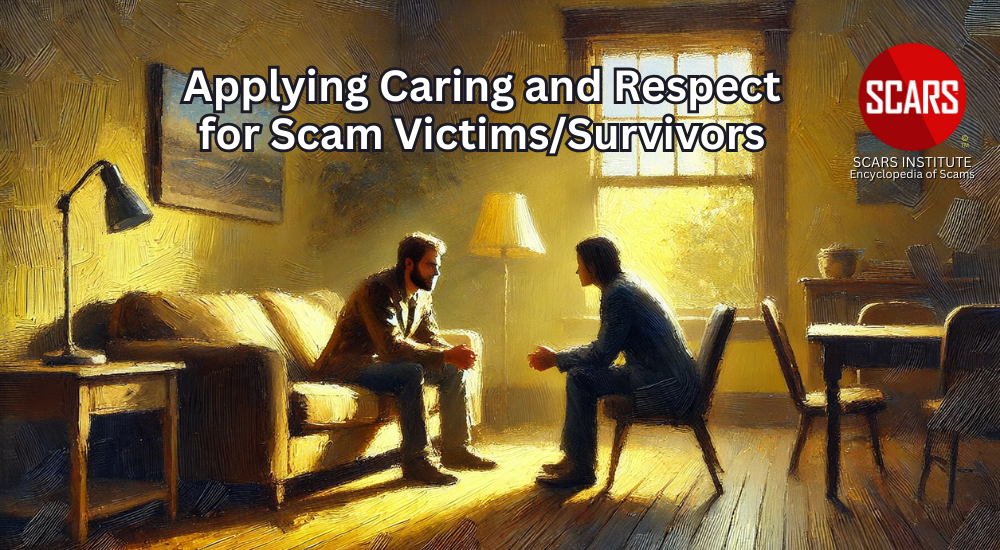Why Young Adults and the Elderly are Most Vulnerable to Cybercrime
Digital Danger Zones: Young Adults and Seniors Face the Highest Risk of Cybercrime
Psychology of Scams – A SCARS Institute Insight
Author:
• Tim McGuinness, Ph.D., DFin, MCPO, MAnth – Anthropologist, Scientist, Director of the Society of Citizens Against Relationship Scams Inc.
Article Abstract
Cybercrime affects everyone, but young adults and older adults face especially high risks due to their unique digital behaviors and emotional vulnerabilities. Young people often overshare online and underestimate the dangers of scams, while seniors may be targeted through trust, fear, or isolation. Each group is vulnerable in different ways—through phishing, fake job offers, tech support scams, or emotionally manipulative schemes like romance fraud and sextortion. Overconfidence is a major risk factor across all ages, leading people to ignore safety measures or dismiss red flags.
Preventing these crimes starts with awareness, open communication, and shared responsibility within families and communities. By staying informed, teaching one another, and creating a culture of digital caution—not fear—we reduce risk for everyone. Cybercrime is not just about stolen money or hacked accounts—it’s about protecting trust, dignity, and emotional safety in a connected world.

The Most Vulnerable: Why Young Adults and the Elderly Are at Higher Risk for Cybercrime
In a hyper-connected world, cybercrime has become a persistent threat to people across all demographics. No one is truly immune. But two age groups consistently emerge as especially vulnerable: young adults under 25 and seniors over 75. Though their digital habits and experiences are worlds apart, both groups face increased exposure to online manipulation, exploitation, and financial harm.
Understanding why these groups are targeted—and how to reduce their risk—is essential for anyone concerned with personal or family safety in today’s digital landscape.
Why Young Adults Are High-Risk Targets
Young adults have grown up with the internet. They are fluent in the language of digital platforms, social media, and instant communication. But that fluency does not necessarily translate to caution. In fact, their confidence in navigating digital spaces often masks a dangerous vulnerability: overexposure.
Most young adults live significant portions of their lives online. They document their relationships, movements, thoughts, and emotions on social platforms. This abundance of publicly available data is a goldmine for cybercriminals. Scammers no longer have to guess what someone likes, fears, or believes. They can simply observe—and then tailor their approach.
Young adults are frequently targeted for:
Phishing scams disguised as messages from friends or brands they follow. Young adults are especially vulnerable to phishing attempts because they often interact with a wide range of online platforms and services. Scammers exploit this by sending fraudulent emails or direct messages that appear to come from familiar contacts, popular influencers, or trusted brands. These messages typically include urgent requests, fake promotions, or links that lead to malicious websites designed to capture login credentials or financial information. Because the communication looks legitimate, many young users don’t pause to verify it before clicking.
Fake online marketplaces offering too-good-to-be-true deals. Scammers often create professional-looking online storefronts or use social media ads to lure young buyers with heavily discounted products, limited-time offers, or rare items. These fake marketplaces collect payment and personal information but deliver nothing in return—or worse, install malware onto the buyer’s device. The promise of a great deal can override caution, especially when the scam is disguised with convincing product photos and fake reviews.
Fraudulent job offers that steal personal or banking information. Inexperienced job seekers are often targeted with job scams that advertise high pay for minimal effort, remote work flexibility, or urgent hiring. Once the applicant responds, the scammer may request sensitive personal information under the guise of background checks, or even ask for bank account access to “set up direct deposit.” In some cases, the victim is asked to purchase equipment or pay onboarding fees, only to discover the job—and employer—don’t exist.
Romance or friendship scams designed to manipulate emotions and gain trust. Young adults, especially those who are socially isolated or emotionally vulnerable, are frequent targets for romance scams. Scammers build relationships through dating apps, social media, or even gaming platforms. They appear caring, attentive, and emotionally invested. Once trust is established, they create a crisis that requires financial help—appealing to the victim’s empathy and desire to help someone they care about. These scams can be deeply damaging both financially and emotionally.
Identity theft, especially when login credentials or sensitive details are stored insecurely or reused across accounts. Young adults often underestimate the risks of poor password hygiene. Reusing the same credentials across multiple platforms—or storing them in plain text on devices—creates an open door for cybercriminals. If one account is breached, others can quickly follow. Personal information exposed during a data breach can be used to open credit cards, apply for loans, or commit other forms of financial fraud in the victim’s name. Many don’t discover the damage until it’s too late.
And beyond scams, many also face harassment, cyberbullying, and reputational harm due to oversharing.
Young adults may feel immune to deception because they’re tech-savvy—but that sense of control is precisely what scammers exploit.
Simple Ways Young Adults Can Stay Safer
Overview
-
-
Limit what you share online—especially on public accounts. Scammers often use your own content against you.
-
Be skeptical of emotional messages that create urgency or pressure you to act quickly.
-
Use strong, unique passwords for every account—and consider using a password manager.
-
Avoid clicking links or downloading files from unknown sources, even if they appear to come from friends.
-
Recognize that anyone can be fooled. Being smart online isn’t about intelligence—it’s about caution and awareness.
-
In-Depth
Limit what you share online: Oversharing is one of the most common ways scammers gather personal information. Details like your full name, birthday, travel plans, job, or relationship status can all be used to craft convincing scams. Keeping your social media profiles private and being selective about what you post reduces your exposure.
Be skeptical of emotional messages: Scammers often create urgency to force a quick decision. Messages that tug at your emotions—like pleas for help, claims you’ve won something, or warnings that your account is at risk—are designed to bypass rational thinking. Pause before responding. If something feels rushed or emotionally charged, it’s likely a red flag.
Use strong, unique passwords: Reusing the same password across multiple platforms puts you at greater risk. If one account is breached, all connected accounts become vulnerable. Use complex passwords, and consider using a password manager to keep track of them securely.
Avoid unknown links and downloads: Links or attachments sent via email, text, or social media—especially from unfamiliar sources—can install malware or lead to phishing sites. Even if a message appears to come from someone you know, verify it if something feels off.
Recognize that anyone can be fooled: Being tech-savvy doesn’t mean you’re immune. Scammers target everyone, and their methods are constantly evolving. Stay humble, stay cautious, and don’t fall into the trap of thinking you’re too smart to be manipulated.
Why the Elderly Face a Different Kind of Risk
Older adults are being targeted by cybercriminals at unprecedented rates. In many cases, they aren’t even aware that the term “cybercrime” applies to them until the damage is done. The combination of limited digital fluency, a high level of trust in others, and social isolation makes them ideal targets for emotionally manipulative tactics.
Common scams that target older adults include:
Tech support scams, where a pop-up warns of a fake virus and urges them to call a number—where a scammer awaits. One of the most common tactics used against older adults is the fake tech support scam. A sudden pop-up appears on their computer screen warning of a virus or system failure. It includes a phone number, urging the user to call for immediate help. When they do, they’re connected to someone posing as a technician from a legitimate company like Microsoft or Apple. The scammer then requests remote access to the device, installs malware, or demands payment for unnecessary “repairs.” This type of scam thrives on fear and urgency—two emotions that can override rational judgment, especially for those less confident with technology.
Phishing emails or phone calls impersonating banks, government agencies, or family members in distress. Many older adults still rely heavily on phone calls and email for communication, making them prime targets for impersonation scams. A scammer might pose as a bank representative warning of suspicious account activity, or as a Social Security official threatening loss of benefits unless action is taken. Others impersonate a distressed family member—often a grandchild—claiming to be in trouble and needing immediate financial help. The messages are crafted to induce panic and prompt the victim to act without verifying the story. Because older adults often want to do the right thing, especially when it involves loved ones or official-sounding requests, these tactics are tragically effective.
Romance scams, especially for seniors who are widowed or lonely. Romance scams targeting seniors are on the rise, particularly among those who have lost a spouse or are navigating isolation. Scammers reach out through dating websites, social media platforms, or even email, often posing as widowed military veterans, retirees abroad, or professionals working overseas. They engage emotionally, building trust through daily messages and affectionate language. Once a strong connection is established, the scammer invents a crisis—hospital bills, travel delays, legal troubles—and asks for money. The victim, emotionally invested and hopeful about the connection, often sends funds without hesitation. These scams can be financially devastating, but the emotional betrayal can be even more difficult to recover from.
Investment fraud, such as fake retirement plans or cryptocurrency schemes. Scammers frequently prey on older adults’ desire for financial security in retirement. Investment scams are disguised as legitimate opportunities, offering high returns with little risk. Victims are lured into fake retirement plans, real estate deals, or cryptocurrency investments that promise stability and growth. The language used often sounds sophisticated and official, with fake documents, websites, and testimonials adding to the deception. Once the money is sent, it disappears. These scams take advantage of seniors’ careful planning and willingness to act on what seems like a responsible opportunity to secure their future.
Impersonation scams, such as “grandparent” schemes where someone pretends to be a family member in urgent need of money. One of the cruelest and most effective tactics is the “grandparent scam.” A scammer calls or sends a message pretending to be a grandchild in trouble—perhaps arrested, stranded in another country, or involved in an accident. They plead for secrecy, saying they don’t want their parents to know, and beg for money to resolve the issue quickly. The scam relies on emotional urgency and the victim’s protective instincts. Many older adults, fearing for their grandchild’s safety, wire money or purchase gift cards before ever confirming the situation. By the time they speak to the real grandchild, it’s too late.
These scams often succeed because they exploit a deep emotional response—fear, empathy, or love. Scammers know that once a senior feels they are helping a loved one or protecting their finances, logic can be bypassed.
Each of these scams exploits the emotional vulnerability and trusting nature of older adults. The attackers are calculating and methodical, knowing exactly how to trigger compliance through fear, love, or urgency. Raising awareness among seniors—and their families—is one of the most powerful tools in reducing the impact of these crimes.
How Families Can Protect Elderly Loved Ones
Overview
-
-
-
Open a regular conversation about online threats without judgment.
-
Remind them to never share personal information by email, phone, or text unless they initiated the contact.
-
Encourage skepticism of unsolicited tech support, prize winnings, or requests for secrecy.
-
Help them set up privacy protections on their devices and online accounts.
-
Teach them to hang up, close the browser, or delete the message when in doubt.
-
-
One of the most powerful things you can say is, “If something feels strange online, call me before you act.”
In-Depth
Start an ongoing conversation: It’s not about delivering a lecture—it’s about creating trust. Talk regularly about digital safety in a way that respects the elderly person’s autonomy. Use examples, keep it simple, and encourage questions without judgment.
Remind them not to share personal details: Make it a clear rule: no giving out Social Security numbers, bank information, passwords, or personal data over the phone, email, or text. If there’s any doubt, the best action is to hang up or close the browser and call someone they trust.
Warn them about fake tech support: Pop-up windows that say “your computer is infected” or unsolicited phone calls claiming to be from Microsoft or Apple are almost always scams. Encourage them to never call those numbers or allow remote access to their device.
Help set up device protections: Install software updates, antivirus protection, and secure passwords on their devices. Set up privacy settings on their email and social media accounts. These small steps reduce the chance of a successful attack.
Encourage them to speak up: Make sure they know it’s never too late to ask for help or report something suspicious. If they feel uncomfortable or unsure about something online, remind them they are not alone—and that asking for help is a strength.
Children and Teens: A Quiet Risk That’s Growing
While the focus is often on adults, children and teens are increasingly targeted by online predators and exploitative schemes. Their risk is less about financial fraud and more about emotional and psychological harm.
Overview
Children are exposed to:
-
-
-
Online grooming by predators pretending to be peers
-
Cyberbullying that can cause severe emotional distress
-
Inappropriate content, sometimes disguised as innocent videos or games
-
Manipulation through gaming communities, where relationships are easily exploited
- Sextortion scams that blackmail teens and pre-teens over intimate images
-
-
Parents cannot afford to be passive about their child’s digital presence. Children may not have the language or awareness to describe what is happening to them—especially if they are being threatened or emotionally blackmailed.
In-Depth
Online grooming by predators pretending to be peers: Online grooming is one of the most dangerous and growing threats to children and teens. Predators often pose as peers on social media platforms, gaming apps, or chat rooms, using fake profiles to establish trust over time. These individuals are patient and manipulative, learning a child’s interests, fears, and vulnerabilities to build an emotional bond. Once that trust is established, they gradually introduce inappropriate topics or requests, often attempting to isolate the child from friends and family. Because the grooming process can seem like a genuine friendship to a child, they may not recognize the danger until it’s too late.
Cyberbullying can cause severe emotional distress: Cyberbullying can be relentless and devastating. Children and teens are highly engaged in digital communication—texting, social media, group chats—and bullying has followed them into those spaces. Hurtful messages, threats, exclusion, and public humiliation can be delivered at any time of day or night, often anonymously. Victims may feel trapped, powerless, or ashamed, leading to anxiety, depression, and in severe cases, self-harm. Unlike traditional bullying, there’s no physical space for refuge. The emotional impact can be long-lasting, and without adult intervention, many children suffer silently.
Inappropriate content, sometimes disguised as innocent videos or games: The internet is filled with content that appears child-friendly but contains disturbing, violent, or sexual material. Clever algorithms and misleading thumbnails make it easy for children to stumble into harmful territory, even when they believe they’re watching a cartoon or playing a harmless game. Some platforms struggle to monitor this type of content effectively, leaving children vulnerable to repeated exposure. This early and unfiltered access to explicit material can have serious developmental consequences, shaping beliefs and emotions in ways children aren’t equipped to process.
Manipulation through gaming communities where relationships are easily exploited: Gaming communities have become social spaces where kids form friendships, join teams, and interact with strangers. While many of these interactions are harmless, they can also become a pathway for manipulation. Predators and scammers target these platforms because they offer access to unsupervised conversations and personal sharing. Children may be pressured to reveal private information, send photos, or download files. Some are manipulated into giving up login credentials, in-game currency, or worse—crossing boundaries they don’t fully understand. The informal, friendly tone of these environments can make it especially difficult for children to recognize red flags.
Parents cannot afford to be passive about their child’s digital presence: Digital risks to children are real, and they are growing more sophisticated. Parents must take an active role in guiding their child’s online experience. This means more than installing filters or limiting screen time—it requires ongoing conversations about trust, safety, and boundaries. Many children, especially teens, are reluctant to report troubling experiences, fearing punishment, shame, or disbelief. Some don’t even realize they’re being manipulated. Creating an open, judgment-free environment where kids feel safe to talk is critical. Parents must lead with curiosity, not interrogation, and be willing to listen without overreacting. Only then can children feel confident coming forward when something feels wrong.
Sextortion scams that use fear and shame to silence victims: Sextortion scams have become an alarming threat to teens and preteens, often starting with what seems like an innocent online conversation. Scammers pose as peers or romantic interests and coax children into sharing explicit photos or videos—sometimes by using fake images themselves. Once the material is obtained, the tone shifts immediately. The scammer threatens to release the images to friends, family, or school unless the child pays money, sends more explicit content, or remains silent. These tactics are deeply traumatic. The fear and shame they create can isolate the victim, making it difficult for them to seek help. Parents and educators need to understand that sextortion is not limited to “reckless” behavior—many victims are manipulated carefully and feel trapped in a terrifying cycle. Prevention begins with education, open communication, and ensuring children know they will be supported, not punished, if they come forward.
Steps Parents Can Take to Keep Kids Safer Online
Overview
-
-
-
Keep communication open and non-judgmental. Kids must feel safe talking about what they encounter.
-
Use parental controls and privacy settings—not as punishment, but as protective tools.
-
Set screen time boundaries and talk about what they’re watching, playing, or reading online.
-
Teach them not to share personal information, including names, schools, or photos with strangers.
-
Model good online behavior. Children watch how adults handle devices and respond to digital risks.
-
-
In-Depth
Create open lines of communication: Let your child know they can talk to you about anything they experience online—good or bad. Reinforce that they won’t be punished for speaking up if something happens. This trust is critical for early intervention.
Set clear boundaries: Establish guidelines for how much time your child can spend online, what apps or games are allowed, and what kind of content is off-limits. Be consistent, and explain the reasons behind the rules so they understand you’re protecting them, not just controlling them.
Use parental controls: Take advantage of tools built into devices and apps that allow you to filter explicit content, manage downloads, and restrict communication with strangers. These settings are not foolproof, but they’re an important first line of defense.
Teach digital skepticism: Help your child understand that not everything online is what it seems. Encourage them to question unusual requests, avoid sharing personal details, and come to you if someone online makes them feel uncomfortable or pressured.
Be involved in their digital life: Know which platforms they’re using, who they’re talking to, and what kind of content they’re seeing. This doesn’t mean spying—it means being an engaged, supportive presence in a space that matters to them.
The Danger of Overconfidence
Across all age groups, overconfidence remains one of the most underestimated risk factors in cybersecurity. Whether it’s young adults who pride themselves on being tech-savvy, middle-aged professionals who assume their experience makes them immune, or seniors who simply trust too easily, the belief that “it won’t happen to me” is widespread—and dangerous. This mindset creates a false sense of security. When people believe they are too smart, too cautious, or too experienced to fall for a scam, they stop questioning what they see. They bypass safety checks, ignore warning signs, and dismiss new threats as problems for other people.
Cybercriminals thrive on this arrogance. They don’t need to be smarter than their targets—they only need to find a moment when someone isn’t paying attention. They design scams to exploit the very confidence people have in their own judgment. They mimic voices of authority, create fake sense of urgency, and use familiarity to build trust. The more certain a person is that they would “never fall for that,” the more likely they are to drop their guard and become a target.
The truth is that scams are never just about money. Financial loss is only one part of the damage. These crimes also inflict emotional harm, undermine psychological stability, and erode trust in others. Victims are often left doubting themselves, feeling humiliated, or unable to speak about what happened. This is what makes scams so dangerous—they don’t just steal money. They change how people think, what they believe, and how they relate to the world around them.
The lesson is clear: no one is too smart to be deceived. Staying safe online isn’t about being confident—it’s about being cautious, informed, and willing to pause before reacting. The moment you think you’re immune is the moment you become most vulnerable.
What Everyone Should Be Doing
Overview
-
-
-
Stay up to date on how scams evolve. They are not static, and neither should your knowledge be.
-
Take all online communication seriously. Whether it’s email, text, or social media, question the source.
-
Verify before acting—especially if money or personal data is involved.
-
Slow down when emotions are high. Scammers thrive on urgency.
-
Encourage open discussion in families about what’s happening online.
-
-
Every age group has strengths and weaknesses. The key to reducing vulnerability is not shame or fear—it is awareness, connection, and honesty.
In-Depth
Stay current with evolving threats: Scammers are always adjusting their tactics. Subscribe to updates from trusted cybersecurity sources, or check in regularly with reputable sites that track the latest scams. What you don’t know can hurt you—but what you learn can protect you.
Treat all online messages with caution: Whether it’s an email, a social media DM, or a text message, approach every unexpected message with a healthy dose of suspicion. If something seems too good to be true, it usually is.
Take your time: Scammers depend on urgency. They want you to react before you think. When in doubt, wait. Think through what’s being asked of you. Verify before you act. The more pressure you feel, the more likely it’s a scam.
Talk about online safety with people you trust: Make cybersecurity part of your regular conversations with friends and family. Ask questions. Share what you’ve learned. The more we normalize these discussions, the better we all become at spotting danger before it strikes.
The Shared Responsibility
Preventing cybercrime is not just a personal duty—it’s a shared one, rooted in communication, collaboration, and mutual awareness across generations. In today’s hyperconnected world, each person in a family or community brings a different kind of digital literacy to the table. Younger adults often have the technical know-how and exposure to the latest online platforms. They can play an essential role by helping their parents or grandparents navigate apps, adjust privacy settings, and recognize red flags like phishing attempts or suspicious pop-ups. A short conversation can prevent a costly mistake.
At the same time, parents can stay engaged by learning from their children—not only about emerging technologies and platforms but also about the digital trends and social dynamics that shape the online experiences of younger generations. Many parents don’t realize how much of their child’s life happens in digital spaces until something goes wrong. By being open, curious, and involved, they can establish trust and foster safer habits early on.
Seniors, though sometimes dismissed as less tech-savvy, offer a critical kind of wisdom. They often have finely tuned instincts from a lifetime of experience. When something feels off—too urgent, too good to be true, too demanding—they are often right. Their ability to question, to slow things down, and to ask for a second opinion can be a powerful defense against emotional manipulation and social engineering.
This intergenerational exchange—where everyone brings something valuable—creates a stronger and more resilient digital culture. Families and communities function best when they work together, and that extends to online safety. Conversations about scams and cyber risks should happen before a crisis, not after. Just like talking about finances, health, or emergency planning, digital safety is part of modern life and deserves regular attention.
We cannot control the existence of scams, fraudsters, or malicious actors online. But we can control how informed and prepared we are to face them. Taking a few moments to explain something, ask a question, or check in with a loved one can make a world of difference. It reminds everyone that they are not alone, and that their safety matters to someone else.
By staying aware, speaking up, and watching out for one another, we lower the risk—not just for ourselves, but for everyone around us. That is the heart of shared responsibility: understanding that the fight against cybercrime is not fought alone. It’s fought together, click by click, conversation by conversation.
Conclusion
Cybercrime doesn’t discriminate—but certain age groups are targeted more frequently and more effectively. Young adults, with their digital confidence and tendency to overshare, and the elderly, with their trusting nature and unfamiliarity with evolving tech, are at heightened risk.
But awareness is protection. Conversation is prevention. And caution is strength.
Staying safe online isn’t about fear—it’s about making thoughtful choices, watching for red flags, and never believing that it “only happens to someone else.”
Because when it comes to cybercrime, it’s not just technology at stake—it’s trust, dignity, and peace of mind.
-/ 30 /-
What do you think about this?
Please share your thoughts in a comment below!
Article Rating
Table of Contents
- Digital Danger Zones: Young Adults and Seniors Face the Highest Risk of Cybercrime
- Article Abstract
- The Most Vulnerable: Why Young Adults and the Elderly Are at Higher Risk for Cybercrime
- Why Young Adults Are High-Risk Targets
- Simple Ways Young Adults Can Stay Safer
- Why the Elderly Face a Different Kind of Risk
- How Families Can Protect Elderly Loved Ones
- Children and Teens: A Quiet Risk That’s Growing
- Steps Parents Can Take to Keep Kids Safer Online
- The Danger of Overconfidence
- What Everyone Should Be Doing
- The Shared Responsibility
- Conclusion
RATE THIS ARTICLE?
LEAVE A COMMENT?
Recent Comments
On Other Articles
- Nikolaus on Dating Scammers Paradise: Ivory Coast: “The Ivory Coast romance scam is still going on. It seems that local authorities don’t handle the issue effectively!” Dec 10, 02:17
- on The SCARS Institute Top 50 Celebrity Impersonation Scams – 2025: “Thank you – we will.” Dec 7, 11:41
- on The SCARS Institute Top 50 Celebrity Impersonation Scams – 2025: “You should add Sean Bean to your list of Celebrities. This one is very good, and persistent. He will be…” Dec 2, 12:07
- on How You Think & Talk About Your Scam Affects Your Recovery: “I have hung on to the scams for far too long. With the intervention of an all-merciful God, I have…” Nov 6, 22:13
- on Disengaging From A Fake Scam Relationship: “Taci, you may want to join our new support community at www.SCARScommunity.org” Nov 6, 03:01
- on Disengaging From A Fake Scam Relationship: “This particular article helped me discover the many things I did wrong the first time I was scammed. I should…” Nov 5, 22:49
- on About the SCARS RomanceScamsNOW.com Website – 24 Years Published: “It was unavailable for a few days, but it is available again. If he would be interested, he is welcome…” Nov 5, 00:59
- on About the SCARS RomanceScamsNOW.com Website – 24 Years Published: “My husband has been scammed and your classes have been helping him but now he can’t seem to access them.…” Oct 26, 14:57
- on Talia Shepard – Impersonation Victim – Stolen Photos – 2024: “Hi, I’m Patrick from Belgium and I found this site by chance, so I just got to know it, and…” Oct 17, 23:46
- on Talia Shepard – Impersonation Victim – Stolen Photos – 2024: “Hallo ik ben Patrick uit Belgie en het is in verband over PayPal. Ik heb het dit jaar spijtig genoeg…” Oct 17, 23:08
ARTICLE META
Important Information for New Scam Victims
- Please visit www.ScamVictimsSupport.org – a SCARS Website for New Scam Victims & Sextortion Victims
- Enroll in FREE SCARS Scam Survivor’s School now at www.SCARSeducation.org
- Please visit www.ScamPsychology.org – to more fully understand the psychological concepts involved in scams and scam victim recovery
If you are looking for local trauma counselors please visit counseling.AgainstScams.org or join SCARS for our counseling/therapy benefit: membership.AgainstScams.org
If you need to speak with someone now, you can dial 988 or find phone numbers for crisis hotlines all around the world here: www.opencounseling.com/suicide-hotlines
A Note About Labeling!
We often use the term ‘scam victim’ in our articles, but this is a convenience to help those searching for information in search engines like Google. It is just a convenience and has no deeper meaning. If you have come through such an experience, YOU are a Survivor! It was not your fault. You are not alone! Axios!
A Question of Trust
At the SCARS Institute, we invite you to do your own research on the topics we speak about and publish, Our team investigates the subject being discussed, especially when it comes to understanding the scam victims-survivors experience. You can do Google searches but in many cases, you will have to wade through scientific papers and studies. However, remember that biases and perspectives matter and influence the outcome. Regardless, we encourage you to explore these topics as thoroughly as you can for your own awareness.
Statement About Victim Blaming
Some of our articles discuss various aspects of victims. This is both about better understanding victims (the science of victimology) and their behaviors and psychology. This helps us to educate victims/survivors about why these crimes happened and to not blame themselves, better develop recovery programs, and to help victims avoid scams in the future. At times this may sound like blaming the victim, but it does not blame scam victims, we are simply explaining the hows and whys of the experience victims have.
These articles, about the Psychology of Scams or Victim Psychology – meaning that all humans have psychological or cognitive characteristics in common that can either be exploited or work against us – help us all to understand the unique challenges victims face before, during, and after scams, fraud, or cybercrimes. These sometimes talk about some of the vulnerabilities the scammers exploit. Victims rarely have control of them or are even aware of them, until something like a scam happens and then they can learn how their mind works and how to overcome these mechanisms.
Articles like these help victims and others understand these processes and how to help prevent them from being exploited again or to help them recover more easily by understanding their post-scam behaviors. Learn more about the Psychology of Scams at www.ScamPsychology.org
Psychology Disclaimer:
All articles about psychology and the human brain on this website are for information & education only
The information provided in this article is intended for educational and self-help purposes only and should not be construed as a substitute for professional therapy or counseling.
While any self-help techniques outlined herein may be beneficial for scam victims seeking to recover from their experience and move towards recovery, it is important to consult with a qualified mental health professional before initiating any course of action. Each individual’s experience and needs are unique, and what works for one person may not be suitable for another.
Additionally, any approach may not be appropriate for individuals with certain pre-existing mental health conditions or trauma histories. It is advisable to seek guidance from a licensed therapist or counselor who can provide personalized support, guidance, and treatment tailored to your specific needs.
If you are experiencing significant distress or emotional difficulties related to a scam or other traumatic event, please consult your doctor or mental health provider for appropriate care and support.
Also read our SCARS Institute Statement about Professional Care for Scam Victims – click here to go to our ScamsNOW.com website.


















Thank you for your comment. You may receive an email to follow up. We never share your data with marketers.